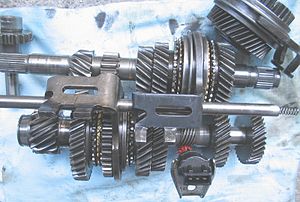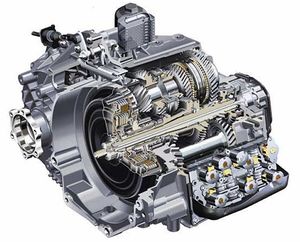Gearboxes
Gearbox is a mechanical device utilized to increase the output torque or change the speed of a motor. The motor's shaft is attached to one end of the gearbox and through the internal configuration of gears of a gearbox, provides a given output torque and speed determined by the gear ratio.
Physical Properties
The physical components of gearboxes vary from one gearbox type to another, as well as differences between manufacturers. Most gearboxes are constructed from steel materials such as iron, aluminum and brass. Unlike other gearbox types, spur gearboxes can also be made with plastics such as polycarbonate or nylon. Other than the raw materials used, the orientation of the gear teeth play a major role in the overall efficiency, torque and speed of the system. Straight gear teeth gearboxes are typically used in low-speed applications. These gearboxes can be noisy, and may have lower overall efficiency. Helical gearboxes are typically used in high-speed applications. These gearboxes are quieter in operation than straight gear teeth gearboxes, which may improve their overall efficiency.
Types of Gearboxes
There are many types of gearboxes manufactured throughout the world. One of the main differences between individual gearboxes is their performance characteristics. Choosing from the various gearbox types is application dependent. Gearboxes are available in many sizes, ratios, efficiencies and backlash characteristics. All of these design factors will affect the performance and cost of the gearbox. There are several types of gearboxes which are listed below:
Bevel Gearbox
There are two types of bevel gearboxes which include either straight or spiral teeth gears. Straight bevel gears have straight and tapered teeth and are used in applications requiring slow speeds. Spiral bevel gears have curved and oblique teeth and are used in applications requiring high-performance, high speed applications.
Physical Properties
Bevel gears are typically constructed from cast iron, aluminum alloy or other steel materials but vary between manufacturers.Gears made from steel materials can be noisy when coming into contact with other gears and also make them prone to wear.
Applications of Bevel Gears
Bevel gearboxes use bevel gears and are mainly used in right angle applications with the shafts in a perpendicular arrangement.
- Print Press
- Power Plants
- Automobiles
- Steel Plants
- Hand Drills
- Differential Drives
Advantages of Bevel Gears
- Right angle configuration
- Durable
Disadvantages of Bevel Gears
- Axes must be able to support forces
- Poorly cut teeth may result in excessive vibration and noise during operation
Helical Gearbox
Helical gears are cut at angles which allow for gradual contact between each of the helical gear teeth. This type of innovation provides for a smooth and quiet operation. Gearboxes using helical gears are applicable in high horsepower and efficient applications.
Physical Properties
Helical gears are typically constructed from cast iron, aluminum allow or iron material but may vary depending on the manufacturer.
Applications of Helical Gears
Helical gears are widely used in applications which require efficiency and high horsepower.
- Oil Industry
- Blowers
- Food and Labeling
- Cutters
- Elevators
Advantages of Helical Gears
- Can be meshed in parallel or cross orientation
- Smooth and quiet operation
- Efficient
- High horsepower
Disadvantages of Helical Gears
- Resultant thrust along axis of gear
- Additives to lubrication
Spur Gearbox
Spur gears are made with straight teeth mounted on a parallel shaft. The noise level of spur gears is relatively high due to colliding teeth of the gears which make spur gear teeth prone to wear. Spur gears come in a range of sizes and gear ratios to meet applications requiring a certain speed or torque output.
Physical Properties
Spur gears are typically constructed from metals such as steel or brass, and plastics such as nylon or polycarbonate. The material used to construct spur gears may vary depending on the manufacturer.
Applications of Spur Gears
Spurs gears are used in applications requiring a decrease in speed with high output torque.
- Cut-to-Length
- Packaging
- Speed Control
- Construction
- Power Plants
Advantages of Spur Gears
- Cost-effective
- High gear ratios
- Compact
- High torque output
Disadvantages of Spur Gears
- Noisy
- Prone to wear
Worm Gearbox
Worm gears are able to withstand high shock loads, low in noise level and maintenance-free but are less efficient than other gear types. Worm gears can be used in right angle configuration. The worm gearbox configuration allows the worm to turn the gear with ease; however, the gear cannot turn the worm. The prevention of the gear to move the worm can be used as a braking system. When the worm gearbox is not active, it is held in a locked position.
Physical Properties
Worm gears are typically constructed of aluminum, stainless steel and cast iron. The material used varies depending on the manufacturer.
Applications of Worm Gears
Worm gears are used in applications requiring high speeds and loads and can be configured for right-angle applications.
- Mining
- Rolling Mills
- Presses
- Elevators/Escalator Drive Systems
Advantages of Worm Gears
- High precision
- Right-angle configurations
- Braking system
- Low noise
- Maintenance-free
Disadvantages of Worm Gears
- Limitations
- Nonreversible
- Low efficiency
Planetary Gearbox
Planetary gearboxes are named so due to their resemblance to the solar system. The components of a planetary gearbox include a sun gear, ring gear and planetary gears. The sun gear is the central gear which is fixed in the center, ring gear (annulus ring) which is the outer ring with inward-facing teeth, and the planetary gears which rotate around the sun gears and mesh with both the sun and ring gear.
Physical Properties
The sun, ring and planetary gears of a planetary gearbox are constructed of aluminum, stainless steel or brass. The material used varies depending on the manufacturer.
Applications of Planetary Gearboxes
Planetary gearboxes are used in applications requiring low backlash, compact size, high efficiency, resistance to shock, and a high torque to weight ratio.
- Slewing Drives
- Lifts
- Cranes
- Machine Tools
- Automotive
Advantages of Planetary Gears
- High power density
- Compact
- Highly efficiency in power transmission
- Greater stability
- Load distribution among planetary gears
Disadvantages of Planetary Gears
- High bearing loads
- Complex design
- Inaccessibility

